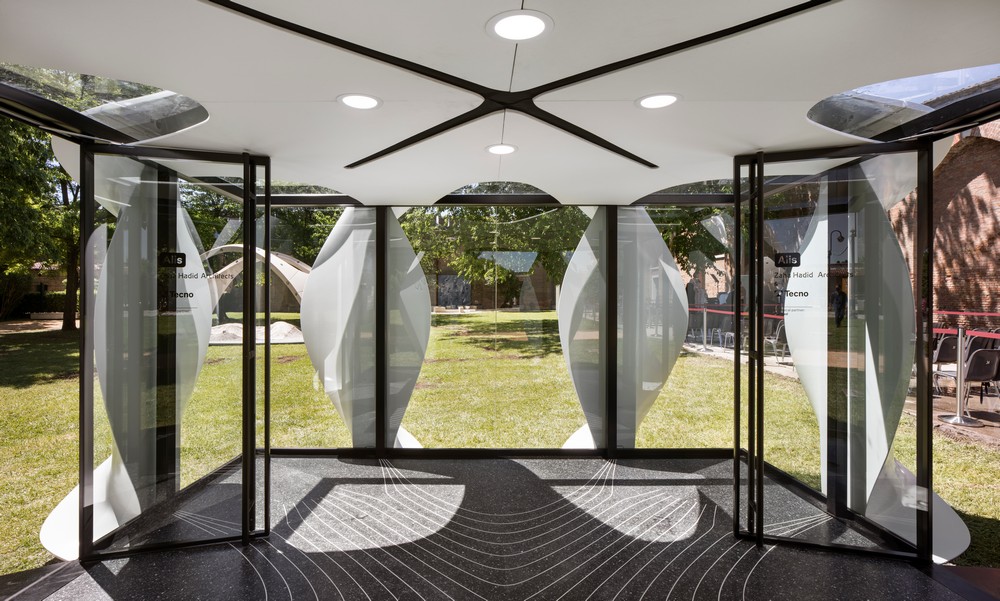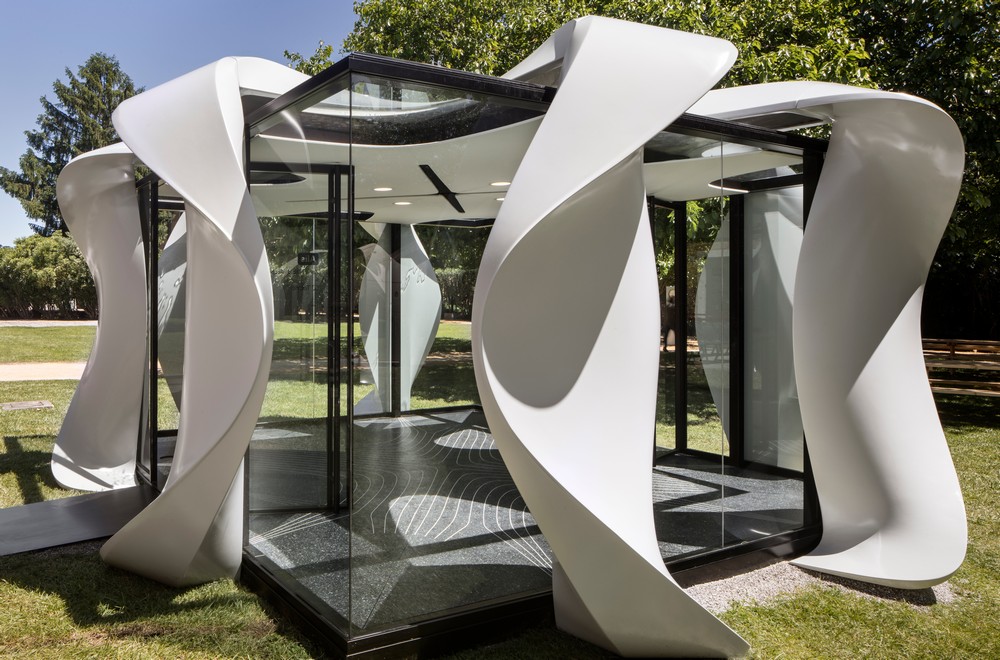Zaha Hadid Architects (ZHA) and furniture manufacturer Tecno have showcased their new ‘ALIS pod’ office concept in the Venice Giardini, and it features a custom plant-based 3D printed floor.
Developed by Amsterdam-based architectural 3D printing firm Aectual, the pod’s distinct base is a carbon-neutral terrazzo flooring. The pattern lines are 3D printed out of linseed (flaxseed), while the aggregate resin is based on a soy material with real marble stone additives.
Aectual’s flooring also comes complete with a red list-free certificate, meaning it doesn’t contain any elements known to pose risks to human health. It is also 100% volatile organic compound (VOC)-free and 100% recyclable.

The ALIS pod
The ALIS pod office concept features an orchid-inspired design, with organic ‘petals’ bounding the four glass walls. The cubic structure measures almost six meters in length, and can be fully customized based on the requirements of the user and the location in which it will be fitted.
Intended as a mobile and modular space to meet with others, the ALIS pod can be installed both indoors and outdoors, in commercial offices as well as stations and airports. It can also be disassembled and transported with ease, with various petal configurations available upon reassembly.
Much like the flooring, the rest of the elements in the pod were also designed with the circular economy in mind. ZHA states that ALIS’ components can be recycled or upcycled for secondary applications once the pod reaches the end of its life, ensuring minimal waste.
Patrik Schumacher, Director of Zaha Hadid Architects, said, “Our work marries innovations in design and operational technologies with advances in ecologically sound materials and sustainable construction practices. We must not look only at the disparate parts, but work to understand them as a whole to deliver the solutions to the defining challenges of our era.”

3D printed Pattern Terrazzo X Durabella Floors
Aectual’s 3D printing system is a six-axis, extrusion-based robotic arm. By running four of these printers together in unison, the firm is able to print over an area of 500 sq. ft, yielding large-scale objects and floor panels that are then welded together.
The company’s 3D printed floor patterns are entirely customizable on a project-by-project basis, meaning customers like Tecno and ZHA are able to integrate way-finding, highlight specific points of interest, and use geometry to create a sense of place and scope. The pattern lines come in any RAL or NCS colors, and the clients can often choose from a wide variety of aggregate infill materials. For the ALIS pod, ZHA opted for Aectual x Durabella aggregate no. 4: a dark green infill with Nero Ebano and Alpi Verde marble.
Due to the slight flexibility of the 3D printed floor, it reportedly won’t crack under heavy foot traffic either. The material is designed to be highly hardwearing, easy to clean, and has better acoustics than traditional cement-based terrazzo flooring. This makes it a viable choice for places like hospitals, hotels, restaurants and shops.

Thanks to the design freedom granted by additive manufacturing, the construction sector can benefit greatly from novel 3D printed architectural designs, as well as potentially lower costs and faster build times. Earlier this month, a 3D printed home called the ‘Fibonacci House’ became the first of its kind to be listed on the popular travel-lodging site Airbnb. Built by Dutch construction start-up Twente Additive Manufacturing, the compact yet luxuriously-upholstered holiday home is now available for rental in the scenic hills of British Columbia, Canada.
Elsewhere, Habitat for Humanity, a non-profit organization dedicated to poverty alleviation, has begun 3D printing affordable housing in Tempe, Arizona. Last month, the organization used a COBOD BOD 2 concrete 3D printer, along with construction firm PERI and several other local partners, to 3D print a single family house with three bedrooms and two bathrooms. Once complete, a Habitat-selected family will be chosen to live in the house.
Nominations for the 2021 3D Printing Industry Awards are now open, have your say in who is leading the industry now.
Subscribe to the 3D Printing Industry newsletter for the latest news in additive manufacturing. You can also stay connected by following us on Twitter, liking us on Facebook, and tuning into the 3D Printing Industry YouTube Channel.
Looking for a career in additive manufacturing? Visit 3D Printing Jobs for a selection of roles in the industry.
Featured image shows the inside of the ALIS pod. Photo via Zaha Hadid Architects.



